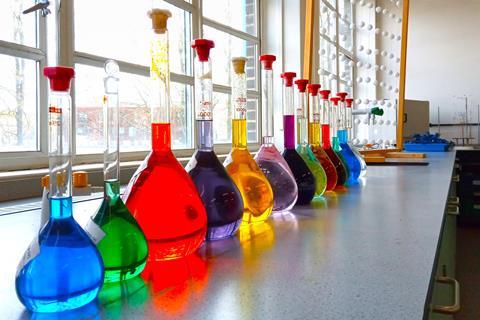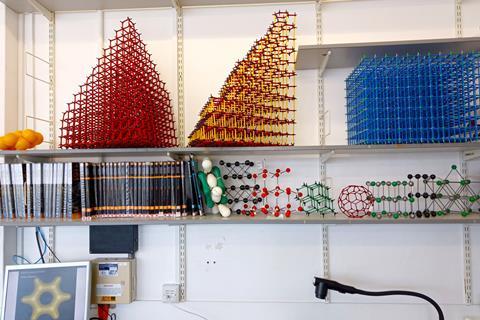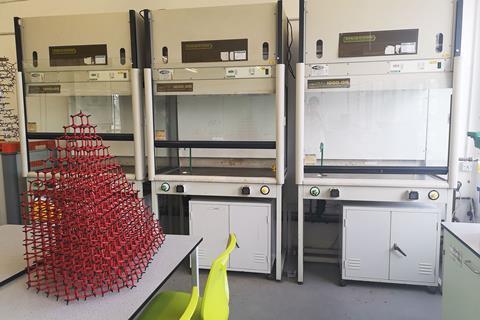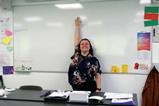You’ll find fantastic models, bright transition metal solutions and a colour scheme with hints of chemical compounds

Meet Simon and Zoë, two dedicated chemistry teachers at Long Road Sixth Form College in Cambridge, who both trained at Cambridge University. And now, with years of experience under their belts – Simon, 18 and Zoë, 24 – they devote their days to making chemistry come alive for their post-16 students. They work with fantastic full-time chemistry technician, Sarah Jarvis, recently awarded registered science technician status.
Simon and Zoë teach the OCR A-level chemistry B (Salters) specification, because they like the synoptic context-led ethos. They’ve also adapted it to suit their cohort over time, developing some new topics and approaches.
Tell us about your school
Zoë: The college is located on the outskirts of Cambridge, but students come from a wide area covering much of East Anglia – from about 110 different secondary schools. Long Road has about 2500 students. The oldest school buildings date from the 1930s and are set around a quad. The grounds are beautiful, with hundreds of trees. The college offers A-levels and Level 3 applied courses, which students can mix up if they choose to.
It’s quite exciting that the electron was discovered just down the road from us, in the old Cavendish Laboratory, and that the structure of DNA was allegedly first proposed in Cambridge’s Eagle pub.

What’s your favourite thing in your lab?
Zoë: I love the view from the window, particularly in autumn when the leaves turn from green to orange. It’s also a useful vantage point to spot students turning up late for class!
The whiteboard is nice and long, which is great for lengthy redox equations and azo dyes. We have an RSC A0-sized periodic table on the wall, set into a frame by our excellent estates team. They also made us a cubic metre and a ping pong ball gold foil, which we use in the first year 12 lesson. And I love our permanent display of transition metal solutions, which provides a colourful backdrop to every lesson.
What’s your classroom set-up like?
Simon: It’s quite a big lab which can easily accommodate a group of 18 to 20 students doing practical work like organic synthesis, which requires lots of equipment. The benches are wide, so students have plenty of space to organise their work areas. They’re set in rows, neatly accommodating the gas taps and sockets, but with a gap through the centre. This gives us excellent views of what the students are doing and allows us to spot potential issues from far away. We also have three fume hoods and the lab is well equipped with common items – glassware, burettes, pipettes, beakers in labelled cupboards. The students have chairs rather than stools, which are more comfortable and quieter.
There’s a second lab on the other side of the building with more moveable benches. We use these for group work. These labs are separated by preparation rooms and a well-equipped chemical store.
What makes your classroom unique?
Simon: The colour scheme is pretty green. We have green chairs, which remind me of solid nickel(II) sulfate, light green cupboard doors, rather like a fresh solution of iron(II) ions and even spruce green lab coats, similar to chromium(III) sulfate solution. The blinds are a contrasting blue, rather like the complex ion from copper(II) ions and ammonia.
Do you have a display you’re particularly proud of?
Zoë: Our model shelf. We started making giant models of structures during lockdown when we were very sad teaching online.
Simon: We have large models of sodium chloride, graphite, diamond and DNA. I enjoy thinking of ways to use these in my teaching, such as getting students to try to determine the actual size of these structures. We also use the models to show students the interesting symmetry present in these structures from certain angles.
Zoë: We’re hoping to build a giant model of a protein next, to help students understand the difference between alpha helices and a double helix.
With an unlimited budget, what would you add to your lab?
Simon: It would be great to have some spectroscopy equipment, like an IR or mass spectrometer, or maybe a gas chromatograph. It would really help make that area of the specification more tangible to students and help them determine whether they’ve achieved success with their organic synthesis. When the spectra are only printed on paper, it’s much harder for students to understand their significance.

















No comments yet